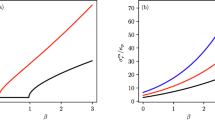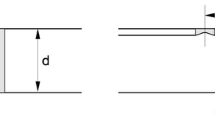Abstract
A direct numerical simulation of a three-dimensional free evolving vortex ring has been performed to understand some features of the dynamics of vortex rings. In previous experiments, a persistent wake has been observed and the direct simulation has clarified the causes of this wake formation. A kinematic alignment analysis of the vorticity vector with the eigenvectors of the strain-rate tensor, together with vorticity visualisations, have been employed to explain the growth of the ‘Widnall’ instabilities. The analysis has shown the presence of two different zones, the first characterised by intense vorticity and low strain rate and the second with opposite features. In the former, there is a ring core which maintains its coherence even in the long term, in the latter there are elongated structures contributing to the deformation of the ring.
Similar content being viewed by others
References
Lasheras, J.C., Lecuona, A. and Rodriguez, P., Three-dimensional structures of the vorticity field in the near region of laminar co-flowing forced jets'. In: Jimènez (ed.),The Global Geometry of Turbulence. Plenum Press (1991).
Glezer, A., The formation of vortex rings.Phys. Fluids 31 (1988) 3532–3542.
Widnall, S.E., Bliss, D.B. and Tsai, C.Y., The instability of short waves on a vortex ring.J. Fluid Mech. 66 (1974) 35–47.
Ashurst, W.T., Kerstein, A.R., Kerr, R.M. and Gibson, C.H., Alignment of vorticity and scalar gradient with strain rate in simulated Navier-Stokes turbulence.Phys. Fluids 30 (1987) 2343–2353.
Verzicco, R. and Orlandi, P., A finite different scheme for direct simulation in cylindrical coordinates. Presented at the ICOSAHOM 92, Montpellier, 1992.J. of Comp. Phys. 274 (1994) 1–25.
Shariff, K.R., Verzicco, R. and Orlandi, P., A numerical study of three-dimensional vortex ring instabilities: Viscous corrections and early non-linear stage.J. Fluid Mech. 274 (1994) 1–25.
Borotav, O.N., Pelz, R.B. and Zabusky, N.J., Reconnection in orthogonally interacting vortex tubes: Direct numerical simulations and quantifications.Phys. Fluids. A 4 (1992) 581–605.
Jimènez, J., Wray, A.A., Saffman, P.G. and Rogallo, R.S., The structure of intense vorticity in isotropic turbulence.J. Fluid Mech. 255 (1993) 65–90.
Jimènez, J. and Orlandi, P., The rollup of a vortex layer near a wall.J. Fluid Mech. 248 (1993) 297–313.
Jimènez, J., Kinematic alignment effects in turbulent flows.Phys. Fluids A 4 (1992) 652–654.
Chong, M.S., Perry, A.E. and Cantwell, B.J., A general classification of three-dimensional flow fields.Phys. Fluids A 5 (1990) 765–777.
Kevlahan, N., Mahesh, K. and Lee, S., Evolution of the shock front and turbulence structures in the shock/turbulence interaction.Proceedings of the 1992 Summer Program, Centre for Turbulence Research NASA.
Wray, A.A. and Hunt, J.C.R., Algorithms for classifications of turbulent structures. In: Moffat and Tsinober (eds),Topological Fluid Mechanics, Proceedings of the IUTAM Symposium. Cambridge (1989).
Author information
Authors and Affiliations
Rights and permissions
About this article
Cite this article
Orlandi, P., Verzicco, R. Identification of zones in a free evolving vortex ring. Appl. Sci. Res. 53, 387–399 (1994). https://doi.org/10.1007/BF00849112
Received:
Accepted:
Issue Date:
DOI: https://doi.org/10.1007/BF00849112




